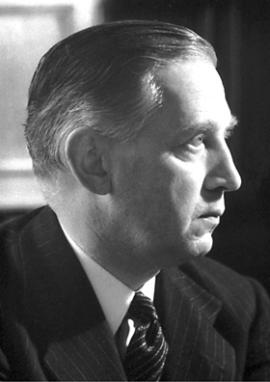 SKC Films Library SKC Films Library |
| SKC Films Library >> Science >> Physics >> Biography |
 Sir Edward V. Appleton Sir Edward V. AppletonNobel Prize winner Edward Victor Appleton was born in Bradford, England, on September 6, 1892. He received his early education at Hanson Grammar School, entered the University of London at age 16, moved to St John's College, Cambridge University, on scholarship at age 18, and received his B.A. in Natural Science with Physics from the latter in 1913. Appleton began his research career in crystallography. That research was interrupted by the First World War, during which he served with the Royal Engineers. During his war service he was introduced to radio, a means of communication then in its infancy in the military, which kindled in him an interest in radio waves. After the war, Appleton returned to Cambridge to do research on atmospheric physics mainly using radio waves. In 1920 he was appointed assistant demonstrator in experimental physics at the Cavendish Laboratory, where he and Balthazar van der Pol began an investigation of the operation of radio vacuum tubes. In 1924 Appleton became Wheatstone Professor of Physics at King's College, London University, and it was there that he discovered that the strength of the radio signals received at Cambridge from the BBC station in London was constant during the day but varied during the night, rising and falling in an almost regular manner. He suggested that, at night, the Cambridge apparatus was receiving not one but two waves, one travelling directly and the other being reflected by the atmosphere. The existence of a reflecting layer had first been suggested around forty years earlier by Balfour Stewart. Using a BBC transmitter, Appleton conducted experiments to prove that this layer (the ionosphere) existed and its position and height above the ground were determined. Further research discovered that there were layers within the ionosphere, each of which reflected radio waves in a different manner. In 1932 he was elected Vice-President of the American Institute of Radio Engineers, and in 1936 he returned to Cabridge as Jacksonian Professor of Natural Philosophy. In 1939 Appleton became the secretary of the Department of Scientific and Industrial Research, in which capacity he oversaw and conducted research on radar, one of the most important developments to come out of World War II. He also demonstrated that ionospheric reflecting power varies with sunspot activities and discovered that sunspots are powerful emitters of short radio waves. The importance of Appleton's work led to a knighthood in 1941 and the Nobel Prize for Physics in 1947. He became principal and vice-chancelllor of the University of Edinburgh in 1949, and remained there for the rest of his life. He died in Edinburgh on April 21, 1965. SOURCES SEE ALSO |
| SKC Films Library
>> Science >> Physics >> Biography This page was last updated on 06/14/2017. |